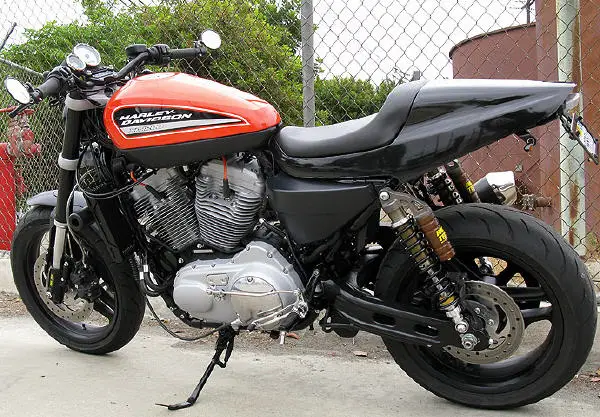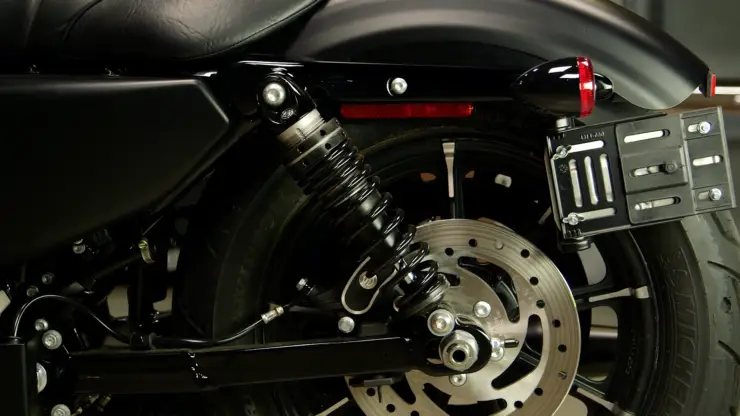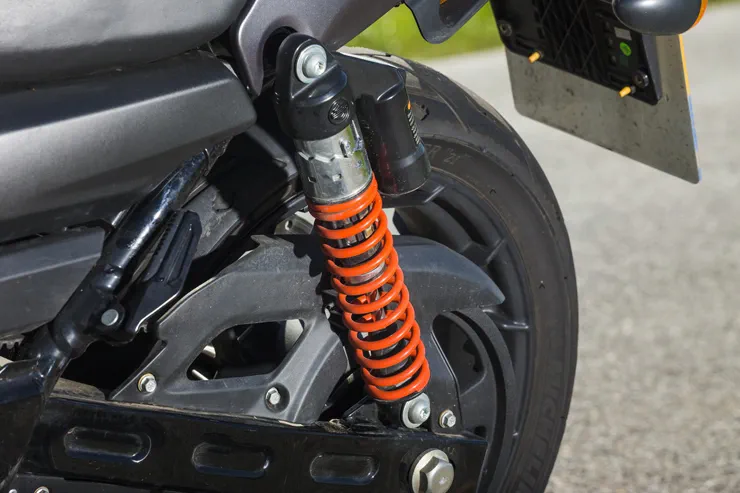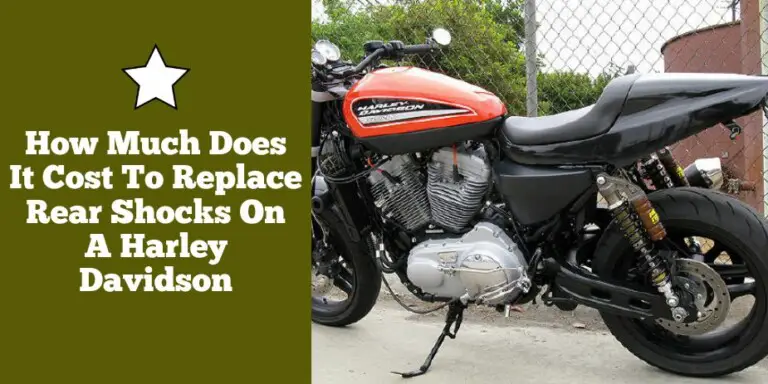Are you wondering how much it costs to replace rear shocks on a Harley-Davidson? It can be a tricky and expensive process, but it doesn’t have to be. In this article, we’ll discuss the costs involved and what you should consider before making the investment.
Replacing rear shocks on a Harley-Davidson can cost between $300 to $700, depending on the brand and whether installation is done professionally.
Read on for tips on how to get the most out of your money, and learn how to keep your Harley-Davidson running smoothly for years to come.
How much does it cost to replace rear shocks on a Harley-Davidson?
As with any mechanical component, the rear shocks on your Harley-Davidson motorcycle will eventually wear out and require replacement. Rear shocks play a major role in providing an extremely smooth and controlled ride, absorbing bumps and vibrations on the road. If you notice any signs of wear or poor performance in your rear shocks, it is important to address the issues promptly to make sure you get optimal safety and comfort during your ride.
>>> Click here to read our review of the Best Rear Shocks For Harley-Davidson <<<
Rear shocks should be replaced in pairs. Compared to the struts, these are less expensive to replace. Struts are a structural component that is very sophisticated. If you’re wondering how much does it cost to replace rear shocks on a Harley-Davidson bike, then you should know typically it starts from $200 and can go as high as $800 or more. The average cost of replacing a high-quality pair of rear shocks will be somewhere between $250 to $580. In fact, it will cost you somewhere between $150 and $300 in labor to finish the job.
If you’re buying shock absorbers separately, then they will cost you between $50 and $140. If you have to replace the rear shocks and struts, then you should multiply the cost by two. This will give you an estimate of the cost of replacement.
The cost of rear shocks can vary significantly based on the type and brand you choose. Harley-Davidson offers an impressive range of rear shocks designed specifically for their models, which are likely to be more expensive due to the brand’s reputation and compatibility with the bike. Alternatively, you can also consider aftermarket shocks from reliable brands, which can be more budget-friendly without compromising quality.
Rear shocks are available in different materials, such as steel or aluminum, and might come with different features such as adjusting damping and preload settings. These features play a role in defining the cost of the rear shocks. Shocks having additional features or advanced technology might come at a higher price point than basic, non-adjustable options.
When you’re replacing the rear shocks on your Harley-Davidson bike, you’ll have the option of choosing OEM parts or aftermarket parts. OEM rear shocks are produced by Harley-Davidson and are designed specifically for your Harley-Davidson model. While OEM parts are often seen as the most reliable and compatible option, they can also be more expensive. Meanwhile, aftermarket parts from reputable manufacturers might offer a more cost-effective solution without compromising quality.
While some Harley-Davidson owners with mechanical expertise might choose to replace rear shocks themselves to save on labor costs, it is important to have the necessary skills and tools for ensuring a proper installation. For those who aren’t experienced in motorcycle maintenance, it is strongly recommended to seek the services of a professional mechanic to ensure that the job is done safely and correctly.

How much do parts cost when replacing rear shocks on a Harley-Davidson bike?
When it comes to replacing the rear shocks on your Harley-Davidson bike, you will have two primary options that you can choose from – OEM rear shocks or aftermarket rear shocks. Each option comes with its own set of advantages and considerations, which also includes the cost. Here is how much OEM rear shocks will cost you compared to how much aftermarket rear shocks will cost you.
OEM rear shocks
OEM rear shocks for Harley-Davidson bikes are produced by Harley-Davidson itself. These rear shocks are designed specifically to match the specifications and compatibility requirements of your motorcycle model. These rear shocks are often considered the most reliable option as they’re made by the manufacturer themselves. They are engineered to provide optimal performance and ensure a smooth and controlled ride that aligns with the brand’s standards.
The cost of OEM rear shocks can vary depending on the model and features of your specific Harley-Davidson bike. On average, OEM rear shocks from Harley-Davidson dealerships might range from $200 to $500 or more per rear shock. You should keep in mind that some high-end or specialized models might have more expensive OEM shocks.
Aftermarket rear shocks
Aftermarket rear shocks are produced by third-party manufacturers and they’re designed to fit various motorcycle models, including Harley-Davidson. These rear shocks often offer a more cost-effective solution compared to OEM shocks, which makes them a popular choice for riders looking for budget-friendly alternatives without compromising quality.
The cost of aftermarket rear shocks can vary significantly based on the brand, material, and features. On average, aftermarket rear shocks for Harley-Davidson motorcycles might range from $100 to $400 per shock. Some reputable aftermarket brand offer rear shocks with adjustable features, progressive damping, and other advanced technologies at higher price points.
Choosing between OEM and aftermarket rear shocks largely depends on your budget, preferences, and specific needs. If you prioritize brand authenticity, precision engineering, and complete compatibility with your Harley-Davidson bike, OEM rear shocks are a reliable choice, although they might come at a higher price. Meanwhile, if you’re looking for cost-effective options without compromising quality, reputable aftermarket rear shocks can be an excellent choice. Many aftermarket brands offer shocks that are specifically designed to provide a comfortable ride and improved handling for your Harley-Davidson bike.
Factors that affect the cost when replacing rear shocks on your Harley-Davidson bike
Replacing the rear shocks on your Harley-Davidson bike is an essential maintenance task that can significantly impact your riding experience. The rear shocks play a massive role in providing a smooth and controlled ride by absorbing shocks and vibrations from the road. When it is time to replace these components, numerous factors come into play that can influence the overall cost of the replacement. Understanding these factors will help you make a well-informed decision and ensure that you get the best value for your investment. Here are some of the key factors that affect the cost when replacing rear shocks on your Harley-Davidson bike.
#1. OEM vs. Aftermarket rear shocks
The choice between OEM rear shocks and Aftermarket rear shocks is one of the most significant factors that affect the cost. OEM rear shocks are produced by Harley-Davidson and are designed to match your bike model’s specifications. While they are known for their reliability and compatibility, they often come with a higher price tag compared to aftermarket rear shocks.
Aftermarket rear shocks, on the other hand, are produced by third-party manufacturers and they’re designed to fit various motorcycle models, offering a much more cost-effective solution without compromising quality.
#2. Material and features
The material and features of the rear shocks can also influence the cost. Rear shocks made from premium materials, such as high-quality steel or aluminum, are likely to be more expensive. Moreover, rear shocks with advanced features like adjustable damping, preload settings, or progressive springs might come at a higher price point than basic, non-adjustable options. You should consider your riding style and preferences to determine which features are worth the additional cost.
#3. Brand reputation and quality
The reputation and quality of the brand you choose can greatly impact the cost of the rear shocks. Well-known and reputable brands with a history of producing high-quality motorcycle parts might charge a premium for their products.
While opting for reputable brands can provide peace of mind in terms of performance and reliability, it is important to do research and rear reviews to ensure you are getting the best value for your investment.
#4. Compatibility and motorcycle model
The specific build and model of your Harley-Davidson motorcycle can also affect the cost of replacing rear shocks. Some Harley-Davidson models require specialized or custom shocks, which can be more expensive than shocks designed for more common models. Make sure that the rear shocks you choose are compatible with your bike’s year, make, and model to avoid compatibility issues and additional expenses.
#5. Labor costs
Labor charges for the replacement of rear shocks will add to the overall cost. The amount of labor needed can vary based on the complexity of the installation and the hourly rate of the mechanic performing the work.
If you have mechanical skills and experience, you might consider replacing the rear shocks yourself to save on labor costs. However, it is important to have the necessary tools and expertise to ensure a proper installation.
#6. Additional parts and services
During the rear shock replacement, other related parts or services might be needed. For example, new bolts, bushings, or gaskets might be required to complete the installation correctly. These additional parts and services can add to the overall cost of the rear shock replacement.
#7. Warranty and support
Some rear shocks come with extended warranties or additional support services, which can affect the overall cost. While warranties can certainly provide added protection and peace of mind, they might also be reflected in the overall price of the rear shocks.

Symptoms that you need to replace rear shocks on your Harley-Davidson bike
For avid Harley-Davidson riders, ensuring that their bike is in optimal condition is essential for a safe and enjoyable riding experience. Rear shocks play a major role in absorbing bumps and vibrations, providing a comfortable and controlled ride. However, over time, these rear shocks can wear out or become damaged, affecting the performance of your Harley-Davidson bike. Here are some of the signs that indicate you might need to replace the rear shocks on your Harley-Davidson bike.
Excessive bouncing and vibrations
If you’re noticing that your Harley-Davidson bike’s rear end bounces excessively or experiences an unusual amount of vibrations, it might be a sign of worn-out shocks. The primary function of rear shocks will be to absorb shocks and bumps, so if they are no longer performing this function effectively, you might experience a rough and uncomfortable ride.
Uneven or sagging rear end
A clear indication of deteriorating rear shocks is when your bike’s rear end appears to be uneven or sagging. When the rear shocks lose their ability to support the weight of the bike and the rider, the rear end might be visibly lower than normal. It can negatively impact the bike’s handling and stability, making it important to address the issue promptly.
Bottoming out
Bottoming out occurs when the rear shocks of your Harley-Davidson bike compress fully and still cannot handle the impact of a bump or pothole. You might feel a harsh jolt through the rear of the bike, and in extreme cases, the tire might even make contact with the fender. This is a significant safety concern and will indicate a need for immediate attention.
Excessive leaks or fluid loss
Inspect your rear shocks for any signs of leaks or fluid loss. Damaged seals or worn-out components can cause hydraulic fluid to leak, compromising the rear shocks’ performance. If you notice any oil or fluid residue around the shock absorbers, it is a clear indication that they might need replacement or repairs.
Wandering or unstable handling
Worn-out rear shocks can result in unstable handling and a feeling of wandering or drifting while riding. This can be particularly noticeable when taking corners or navigating uneven road surfaces. If your Harley-Davidson motorcycle feels controlled or exhibits erratic behavior, it might be time to assess the condition of the rear shocks.
Excessive wear on tires
Faulty or worn-out rear shocks can result in uneven tire wear. If you notice irregular wear patterns on the rear tire, it could be due to the rear shocks not providing adequate support and causing the tire to make inconsistent contact with the road.
How to replace rear shocks on a Harley-Davidson motorcycle?
Replacing the best rear shocks on your Harley-Davidson bike is a rewarding upgrade that can significantly enhance your riding experience. Whether you are seeking improved comfort, better handling, or simply replacing worn-out shocks, a proper installation is important for optimal performance and safety. While the process might seem a daunting task for some, with the right tools, preparation, and attention to detail, you can successfully install new rear shocks and enjoy a more enjoyable ride. Here are the steps you should follow to replace the rear shocks on a Harley-Davidson bike.
Before you purchase new rear shocks, make sure that they are compatible with your Harley-Davidson bike. Different bikes have varying suspension setups and not all rear shocks are designed to fit every bike. Check the manufacturer’s specifications and consult with experienced mechanics or Harley-Davidson experts to confirm that the rear shocks you choose are the correct fit for your bike.
Step 1: Prepare for the replacement
Before you start the installation, you will need to gather all the required tools and equipment. You will require a socket set, wrenches, torque wrench, jack or lift, and any other parts that come with your new rear shocks, such as bushings or mounting hardware.
If you’ve got the mechanical skills and experience working on bikes, you might consider installing the rear shocks yourself. However, if you aren’t sure or lack the necessary tools, it is best to seek professional assistance. A qualified mechanic with experience in Harley-Davidson bikes can ensure a precise and safe installation.
The installation of rear shocks is a critical aspect of your motorcycle’s safety and stability. Pay close attention to torque specifications and follow the manufacturer’s instructions carefully. Moreover, after installing the new shocks, take your bike for a test ride in a safe environment to ensure everything is functioning correctly before embarking on longer journeys.
Step 2: Elevate the rear of your bike
Using a jack or a lift, elevate the rear of your bike to provide easy access to the rear shocks. Make sure that the bike is securely supported to prevent any accidents during the installation process.

Step 3: Remove the old rear shocks
With the rear of the motorcycle elevated, you should use a socket and wrench to remove the nuts and bolts securing the old rear shocks. Take notes of the order in which the components are removed as you’ll have to reinstall them in the same sequence with the new shocks.
Step 4: Install the new rear shocks
Carefully position the new rear shocks into place, aligning them with the mounting points on the frame. Insert the nuts and bolts and hand-tighten them to secure the rear shocks. Use a torque wrench for tightening the bolts to the manufacturer’s recommended specifications. It is important to follow the specified torque values to prevent overtightening or undertightening, which can lead to safety issues.
Step 5: Check for proper alignment and clearance
After installing the new rear shocks, you should check for proper alignment and clearance. Make sure that the rear shocks aren’t interfering with any other parts of the bike. The shocks should have enough clearance to compress and rebound freely without any obstructions.
Step 6: Adjust the rear shocks
If your new rear shocks have adjustable features, such as damping or preload settings, now will be the time to make adjustments to match your riding style and weight. Consult the manufacturer’s instructions or seek guidance from experienced riders or mechanics for proper adjustments.
Step 7: Lower the motorcycle and test ride
Once the installation is done, you should carefully lower the motorcycle back to the ground. Before embarking on longer rides, you should take your motorcycle for a test ride in a safe and controlled environment. Pay close attention to the handling, comfort, and stability of the motorcycle to ensure that the new rear shocks are performing optimally.
Step 8: Regular maintenance and inspection
After installing the new rear shocks, you should establish a regular maintenance routine for inspecting the rear shocks for any signs of wear, leakage, or damage. Regular maintenance will help extend the life of the rear shocks and ensure that they continue to provide a smooth and controlled ride.
FAQ
How much does it cost to replace rear shocks on a Harley Davidson?
The cost of replacing rear shocks on a Harley Davidson will vary depending on the type of shocks needed and where they are purchased. Generally, a set of high-quality shocks for a Harley Davidson can range from $100 to $500. It is important to consult with a qualified mechanic for an exact cost estimate.
What is the difference between OEM and aftermarket shocks for a Harley Davidson?
OEM shocks are original equipment manufacturer shocks that are made specifically for your Harley Davidson. They usually provide the best fit and performance, but may be more expensive. Aftermarket shocks are made by a third-party manufacturer and can provide a more cost-effective solution, but may not provide the same level of quality and performance as OEM shocks.
What are the benefits of replacing rear shocks on a Harley Davidson?
Replacing the rear shocks on a Harley Davidson can provide several benefits, including improved handling, better ride comfort, and better overall performance. New shocks can also help reduce wear on other components and improve the longevity of your motorcycle. It is important to consult with a qualified mechanic to determine which type of shocks are best for your needs.
>>> Read more about Rear Shocks for Harley-Davidson <<<

